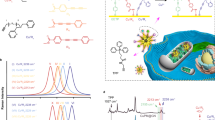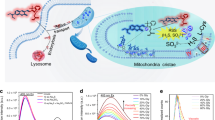Abstract
Coppersensor-1 (CS1) is a small-molecule, membrane-permeable fluorescent dye for imaging labile copper pools in biological samples, including live cells. This probe, comprising a boron dipyrromethene (BODIPY) chromophore coupled to a thioether-rich receptor, has a picomolar affinity for Cu+ with high selectivity over competing cellular metal ions. CS1 fluorescence increases up to 10-fold on binding to Cu+. In this protocol we describe the synthesis of CS1 and how to use this chemical tool to investigate intracellular levels of labile copper in cultured cells. The preparation of CS1 is anticipated to take 4–5 d, and imaging assays can be performed in 1–2 d with cultured cells.
This is a preview of subscription content, access via your institution
Access options
Subscribe to this journal
Receive 12 print issues and online access
$259.00 per year
only $21.58 per issue
Buy this article
- Purchase on Springer Link
- Instant access to full article PDF
Prices may be subject to local taxes which are calculated during checkout



Similar content being viewed by others
References
Lippard, S.J. & Berg, J. Principles of Bioinorganic Chemistry (University Science Books, Mill Valley, CA, 1994).
Tapiero, H., Townsend, D.M. & Tew, K.D. Trace elements in human physiology and pathology. Copper. Biomed. Pharmacother. 57, 386–398 (2003).
Puig, S. & Thiele, D.J. Molecular mechanisms of copper uptake and distribution. Curr. Opin. Chem. Biol. 6, 171–180 (2002).
Prohaska, J.R. & Gybina, A.A. Intracellular copper transport in mammals. J. Nutr. 134, 1003–1006 (2004).
Huffman, D.L. & O'Halloran, T.V. Function, structure, and mechanism of intracellular copper trafficking proteins. Annu. Rev. Biochem. 70, 677–701 (2001).
Field, L.S., Luk, E. & Culotta, V.C. Copper chaperones: personal escorts for metal ions. J. Bioenerg. Biomembr. 34, 373–379 (2002).
Arnesano, F., Banci, L., Bertini, I. & Ciofi-Baffoni, S. Perspectives in inorganic structural genomics: a trafficking route for copper. Eur. J. Inorg. Chem. 1583–1593 (2004).
Brem, S.S. et al. Inhibition of angiogenesis and tumor growth in the brain. Suppression of endothelial cell turnover by penicillamine and the depletion of copper, an angiogenic cofactor. Am. J. Pathol. 137, 1121–1142 (1990).
Brewer, G.J. Anticopper therapy against cancer and diseases of inflammation and fibrosis. Drug Disc. Today 10, 1103–1109 (2005).
Nath, R. Copper deficiency and heart disease: molecular basis, recent advances and current concepts. Int. J. Biochem. Cell Biol. 29, 1245–1254 (1997).
Connor, J.R. Metals and Oxidative Damage in Neurological Disorders (Plenum Press, New York, 1997).
Sigel, A. & Sigel, H., eds. Metal Ions in Biological Systems: Interrelations Between Free Radicals and Metal Ions in Life Processes, Vol. 36 (Dekker, New York, 1999).
Waggoner, D.J., Bartnikas, T.B. & Gitlin, J.D. The role of copper in neurodegenerative disease. Neurobiol. Dis. 6, 221–230 (1999).
Bush, A.I., Masters, C.L. & Tanzi, R.E. Copper, β-amyloid, and Alzheimer's disease: tapping a sensitive connection. Proc. Natl. Acad. Sci. USA 100, 11193–11194 (2003).
Barnham, K.J., Masters, C.L. & Bush, A.I. Neurodegenerative diseases and oxidative stress. Nat. Rev. Drug Discov. 3, 205–214 (2004).
Bellingham, S.A. et al. Gene knockout of amyloid precursor protein and amyloid precursor-like protein-2 increases cellular copper levels in primary mouse cortical neurons and embryonic fibroblasts. J. Neurochem. 91, 423–428 (2004).
Vulpe, C., Levinson, B., Whitney, S., Packman, S. & Gitschier, J. Isolation of a candidate gene for Menkes disease and evidence that it encodes a copper-transporting ATPase. Nat. Genet. 3, 7–13 (1993).
Bull, P.C., Thomas, G.R., Rommens, J.M., Forbes, J.R. & Cox, D.W. The Wilson disease gene is a putative copper transporting P-type ATPase similar to the Menkes gene. Nat. Genet. 5, 327–337 (1993).
Valentine, J.S. & Hart, P.J. Misfolded CuZnSOD and amyotrophic lateral sclerosis. Proc. Natl. Acad. Sci. USA 100, 3617–3622 (2003).
Bruijn, L.I., Miller, T.M. & Cleveland, D.W. Unraveling the mechanisms involved in motor neuron degeneration in ALS. Annu. Rev. Neurosci. 27, 723–749 (2004).
Furukawa, Y. & O'Halloran, T.V. Amyotrophic lateral sclerosis mutations have the greatest destabilizing effect on the apo- and reduced form of SOD1, leading to unfolding and oxidative aggregation. J. Biol. Chem. 280, 17266–17274 (2005).
Hart, P.J. Pathogenic superoxide dismutase structure, folding, aggregation and turnover. Curr. Opin. Chem. Biol. 10, 131–138 (2006).
Brown, D.R. & Kozlowski, H. Biological inorganic and bioinorganic chemistry of neurodegeneration based on prion and Alzheimer diseases. Dalton Trans. 1907–1917 (2004).
Millhauser, G.L. Copper binding in the prion protein. Acc. Chem. Res. 37, 79–85 (2004).
Tsien, R.W. & Tsien, R.Y. Calcium channels, stores, and oscillations. Annu. Rev. Cell Biol. 6, 715–760 (1990).
Yang, L. et al. Imaging of the intracellular topography of copper with a fluorescent sensor and by synchrotron X-ray fluorescence microscopy. Proc. Natl. Acad. Sci. USA 102, 11179–11184 (2005).
Zeng, L., Miller, E.W., Pralle, A., Isacoff, E.Y. & Chang, C.J. A selective turn-on fluorescent sensor for imaging copper in living cells. J. Am. Chem. Soc. 128, 10–11 (2006).
Tanaka, M. et al. Synthesis and metal-ion binding properties of monoazathiacrown ethers. J. Org. Chem. 66, 7008–7012 (2001).
Author information
Authors and Affiliations
Corresponding author
Ethics declarations
Competing interests
The authors declare no competing financial interests.
Rights and permissions
About this article
Cite this article
Miller, E., Zeng, L., Domaille, D. et al. Preparation and use of Coppersensor-1, a synthetic fluorophore for live-cell copper imaging. Nat Protoc 1, 824–827 (2006). https://doi.org/10.1038/nprot.2006.140
Published:
Issue Date:
DOI: https://doi.org/10.1038/nprot.2006.140
This article is cited by
-
A Novel Water Soluble Bipyrazolic Tripod Azoic Dye as Chemosensor for Copper (II) in Aqueous Solution
Chemistry Africa (2019)
-
Spacer-free BODIPY fluorogens in antimicrobial peptides for direct imaging of fungal infection in human tissue
Nature Communications (2016)
-
New family of fluorogenic azacrown probes with identical cavity size but different electronic environment outside the macrocycle: effects on sensitivity of Cu2+ detection
Journal of Inclusion Phenomena and Macrocyclic Chemistry (2015)
-
Opportunities in multidimensional trace metal imaging: taking copper-associated disease research to the next level
Analytical and Bioanalytical Chemistry (2013)
-
Functional characterisation of metal(loid) processes in planta through the integration of synchrotron techniques and plant molecular biology
Analytical and Bioanalytical Chemistry (2012)
Comments
By submitting a comment you agree to abide by our Terms and Community Guidelines. If you find something abusive or that does not comply with our terms or guidelines please flag it as inappropriate.



